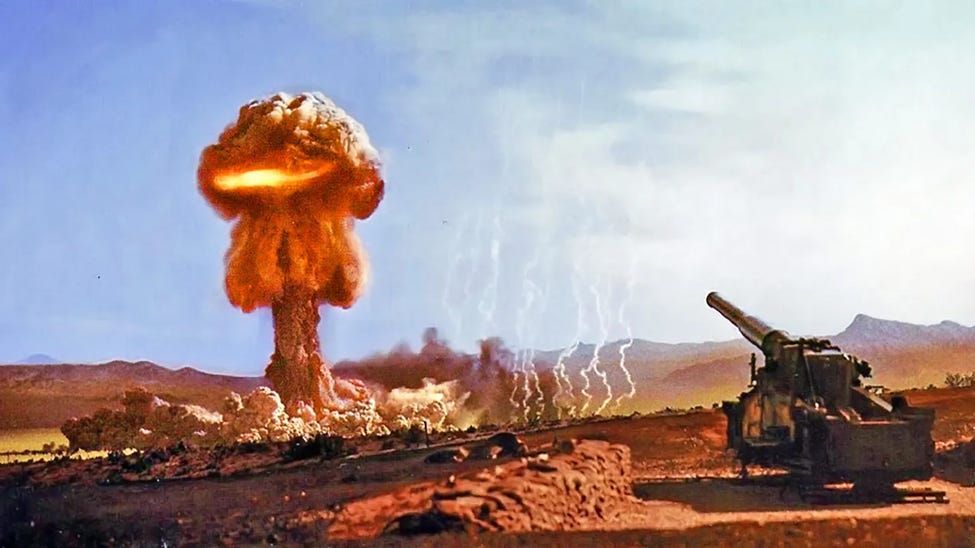NOTE: I’ve been doing research on the Pakistan/India crisis. Particularly on nuclear weapons and mutually assured destruction (MAD). Read that research here. During the crisis, Pakistan did something that should give all of us pause: it brought up tactical nuclear weapons. Again.
Pakistani officials didn’t just make vague references to deterrence. They test-launched short-range, nuclear-capable missiles and invoked the possibility of nuclear use in direct response to Indian strikes. Behind the scenes, analysts and military insiders pointed to Pakistan’s explicit doctrine of deploying “tactical” nuclear weapons to counter India’s conventional military strength.
That got me thinking.
There’s no such thing as a tactical nuclear weapon.
There may be warheads labeled as “low yield.” There may be missiles with battlefield range. But the moment one is used—anywhere, against anyone—the consequences are global. You don’t get a localized nuclear war. You get strategic fallout, ecologically, politically, economically, and militarily.
Tactical use? That’s a fantasy. All use is strategic.
The phrase “tactical nuclear weapon” is a dangerous misnomer. It implies that a nuclear weapon, if small enough or used sparingly enough, can be separated from strategic consequences. It can’t. The first use of any nuclear weapon—regardless of yield, target, or intent—collapses the firewall between conventional and nuclear war. That line, once crossed, cannot be uncrossed. And the fallout—political, economic, and military—is global.
This is why talk of “tactical nukes” should be viewed not as a real option, but as a bluff meant to instill paralysis. Because the moment one is used, the cost is catastrophic and irreversible.
Hate Subscriptions? Me too! You can support me with a one time contribution to my research at Buy Me a Coffee. https://buymeacoffee.com/researchukraine
Nuclear Use Isn’t Escalation—It’s Rupture
The theory is seductive: use a small-yield nuclear device on a remote battlefield, achieve a quick win, and shock your opponent into backing down. But in practice, this idea fails for a simple reason—nuclear use transforms the nature of the war immediately. It’s not a battlefield message. It’s a global one.
Even a single battlefield detonation would force other nuclear powers—especially NATO—to assume strategic intent. No alliance, no military, and no public can afford to interpret a nuclear use as a one-off. Once the threshold is crossed, every nuclear arsenal on Earth starts calculating response timelines. The clock starts ticking.
Strategic Costs of Tactical Illusions
If Vladimir Putin were to use a nuclear weapon—even one dropped in an unpopulated area to “send a message”—the price wouldn’t be a scolding. It would be global retribution. Among the first consequences: full NATO entry into the war. The conflict in Ukraine would cease to be a proxy struggle. The West would be in it, openly, and Russia would face full-spectrum warfare—from the air, the sea, and cyberspace.
The cyber retaliation would be severe. Everything that’s been held in reserve—backdoors into Russia’s banking system, utilities, military networks—would be deployed. Lights would go out. Communications would fail. Russia’s command and control structures would falter in real time.
At the same moment, all remaining restrictions on Western military aid to Ukraine would vanish. The U.S. and NATO would no longer be constrained by fears of escalation. The goal would shift from preventing a Russian victory to ensuring a Russian defeat. Ukraine would be given every tool it needs—long-range missiles, fighter jets, real-time targeting, unrestricted battlefield intelligence. There would be no more red lines. Only forward momentum.
Energy infrastructure would be fair game. No more limits around pipelines, depots, or export terminals. The shadow fleet—used to launder oil around sanctions—would be hunted, boarded, and sunk where necessary. Russia’s energy economy would not be sanctioned; it would be dismantled.
Then there’s China and India. It’s often assumed they would hedge or remain neutral. But the numbers say otherwise. In 2024, Russia accounted for just 8.3% of India’s total trade. The EU and U.S. combined represent over 23%. China is even more stark—Russia comprised only about 3.9% of China’s trade in 2023, compared to double-digit figures for the U.S. and EU. If faced with hard secondary sanctions, neither Beijing nor New Delhi would burn their access to Western markets to preserve ties with a pariah.
And neutrality would collapse elsewhere, too. Brazil, South Africa, Gulf states—any country on the fence would be pushed off it. Nuclear taboo matters. Break it, and even the ambivalent turn against you. The reputational loss is not temporary. It becomes structural.
Some analysts speculate that tactical use could be limited—targeting a Ukrainian army group in an open field, or a warning shot over the Black Sea. But there’s no such thing as limited once nuclear use is on the table. The fear alone changes every calculation. Even a supposedly “surgical” strike blows up the international order. It opens the door to Iran, North Korea, and others asking: if Russia gets away with it, why not us?
That’s the real cost. It’s not just the battlefield. It’s the precedent.
The Off-Ramp Trap
The hard part in all of this is accepting that you cannot coddle a nuclear-armed autocrat without inviting more danger. The instinct to de-escalate—to give Putin an “off ramp”—feels responsible. But it’s a trap. Not just for Ukraine, but for every future confrontation.
Being scared of nuclear escalation invites it. It validates a playbook. Escalate, then demand de-escalation on your terms. Take land, hold hostages, fire missiles—then back off just enough to seem “reasonable.” In return: money, aid, land, or political concessions. What starts as aggression ends in negotiation. It works. It’s working.
Dictators are watching. China is watching. If Russia uses a nuclear weapon and the West backs down or rushes to offer deals, what lesson gets learned? That the first to escalate wins. That nukes work.
This is the paradox: avoiding escalation in the short term makes escalation more likely in the long term. The only way to preserve nuclear deterrence is to call the bluff—and make clear that even one so-called “tactical” use will bring strategic consequences no regime can survive.
Benjamin Cook continues to travel to, often lives in, and works in Ukraine, a connection spanning more than 14 years. He holds an MA in International Security and Conflict Studies from Dublin City University and has consulted with journalists and intelligence professionals on AI in drones, U.S. military technology, and open-source intelligence (OSINT) related to the war in Ukraine. He is co-founder of the nonprofit UAO, working in southern Ukraine. You can find Mr. Cook between Odesa, Ukraine; Charleston, South Carolina; and Tucson, Arizona.
Hate Subscriptions? Me too! You can support me with a one time contribution to my research at Buy Me a Coffee. https://buymeacoffee.com/researchukraine
Mr. Cook’s Substack:







I've always preferred to believe the same way, that the only really surefire way to lose a war is to use nukes, but honestly: the recent political events made me having some doubts. I think/fear that Trump would just shrug it off and take it as the natural right of the strong.
Not a good feeling.
>>The cyber retaliation would be severe.
The actual cyber warfare capabilities are some ridiculously overestimated since the time the whole Snowden-popular stuff came out. At 'home turf' several things can be done (mostly to harmless people, though), but on Russian (or Chinese, or so) net it's way too limited.
Today's "low-yield tactical nukes" are more powerful than those used to demolish Hiroshima & Nagasaki in 1945... And the fallout after a nuclear war would be, well, literal.